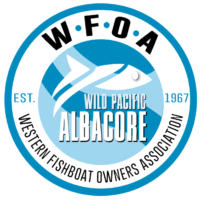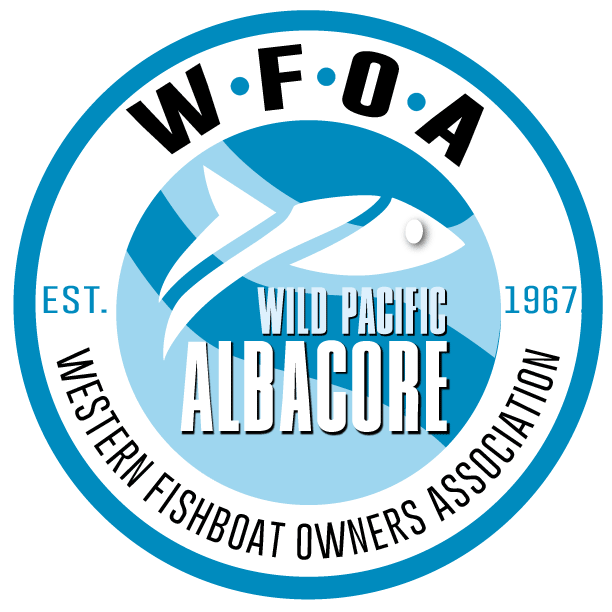ABOUT ALBACORE JIG BOATS:
Commercial fishing vessels that troll for albacore are called “jig boats” because they fish with fishing lures called jigs. Trolling means to catch fish by towing a lure or baited hook behind a slow-moving boat. In the albacore fishery, trollers attach ten to twenty fishing lines to each of the vessel’s poles (outriggers).
These fishing lines are of different lengths and are spread out along each pole to help prevent them from getting tangled up with each other. Attached to the end of each line is a jig — a kind of rubbery fishing lure with a hook in it. Jigs are shaped to look like squid and are available in a wide variety of colors.
The jigs are trailed in the water behind a moving boat, and some albacore will bite a squid-like jig and get hooked.
There is a cord running from each fishing line to the boat. When a fish bites a lure and is hooked, the fisherman grabs the cord — called the “inhauler” — to pull the fishing line to the boat. When the line is within reach, the fisherman grabs it and then hauls in the fish by hand or with a small hydraulic puller.
Once the fish is to the boat, the fisherman swings the albacore out of the water, over the transom, and onto a slanted table where the hook is removed from the fish’s mouth.
The jig is then tossed back overboard and allowed to play back out while the fisherman scrambles to bleed and prepare the albacore for freezing, then pull in more fish.
Though some fishermen may believe that fish prefer one color over another, it is more likely that jigs are colored for marketing reasons.
There are also a couple of extra fishing lines trailing directly off the back of the boat rather than the poles; they’re not attached to inhaulers because they are already within reach.
POLES: The vessel’s poles, also called outriggers, stabilize the boat on the water and also increase the work area of the boat. They are made of wood, steel, or aluminum; on albacore jig boats, up to five or six fishing lines are deployed from each pole.
They are raised straight up into the air and secured to the crosstree when not in use.
THE MASTHEAD LIGHT: A white light is at or near the masthead and must be turned on at night. On smaller vessels — those less than 50 meters (164.1 feet) long — the light must shine in an unbroken arc from dead ahead to 22.5 degrees abaft (that is, behind and toward the stern) of the beam on both sides of the boat. A second masthead light is required for larger vessels (50 meters or greater), and the two masthead lights must be spaced at least one-fourth of the length of the vessel.
Many other lights are required for vessels at sea — including running lights, stern lights, and various others. The International Marine Educators’ website at BoatSafe.com includes animated tutorials to learn what different kinds of lights are used.
About the crosstree: In the old days the crosstree was sometimes used in place of the hangman’s tree — captains would occasionally use it to hang an unruly crewman! A more modern and practical use is using the crosstree (also called the yardarm) as a place to install antennas for electronics; it’s also convenient to stand on while fixing different parts of the rigging. The crosstree is made of durable material — steel pipe, iron, thick-walled aluminum, or hardwood — because it must be strong enough to support the weight of a crewmember and whatever tools or equipment one might need while teetering around up in the rigging. There are also specially designed U-shaped fixtures on the ends of the crosstree for securing the vessel’s poles in the upright position when not in use.
A radar system is used to avoid collisions with other vessels or objects, and for navigation at night or in poor visibility. Radar systems electronically broadcast brief pulses (anywhere from 600 to 4,000 per second) of super-high-frequency radio waves. These waves — broadcast at the speed of light — bounce off objects and reflect back to the radar unit to show the position, size, and distance of each object relative to the vessel on the boat’s screen.
The radar range can be adjusted to suit circumstances. For example, when traveling along the coast, by a harbor, or relatively close to an object at sea, one may set the unit to show everything within three miles. When out on the open ocean a far greater range — showing objects 24 or more miles away — is more appropriate. The radar’s range tends to be limited by the height of the antenna rather than by its power (i.e., the higher the antenna, the greater the range).
The waves reflect best off metal objects, so many wooden boats and other non-metal objects are equipped with a radar reflector to ensure they will be “seen” by boat crews.
About GPS: There are no road signs, highway markers, or landmarks out on the open ocean … just water, and more water, for as far as you can see in all directions. It’s not easy to figure out exactly where you are unless you know how to read the stars (celestial navigation) or have an onboard GPS unit.
GPS stands for “global positioning system.” Originally developed by the U.S. Department of Defense, GPS uses signals from orbiting satellites to tell you exactly where you are. More specifically, a GPS receiver on a vessel finds signals from three or four satellites and automatically calculates time differences between the transmitted signals to determine position. GPS can calculate any position within roughly 15 meters (49 feet) of accuracy anywhere on earth.
Most fishermen connect their GPS receiver to an electronic plotter that displays the vessel’s position on a chart (map) of the ocean. They can also tell the plotter where they want to go, and the plotter then automatically plots the course from the current position to the desired destination. The vessel can even “drive itself” there if the plotter is connected to an autopilot system.
GPS and a plotter can also tell you where an object or location is relative to your position. For example, if someone falls overboard, the captain will quickly punch a button on the plotter to log in the exact location of where that person was last seen. That location is called a “waypoint.” The captain will then turn the boat around to find and rescue the missing person. Boats, though, do not turn on a dime, and can be quickly pushed far away from the original location by the wind and waves — especially in a storm. It is also very easy to become disoriented (particularly at night) and lose sight of the area where the missing person entered the water — but GPS and the plotter can help guide the captain to the waypoint.

